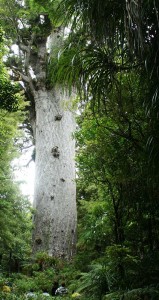New Zealand Adventure 2014
My husband and I recently visited New Zealand with the UW-Stevens Point Adventure Tours program. When it’s snowy and cold in Wisconsin, it’s summer in New Zealand! As hiking was the main focus of the tour, we quickly made friends with the others traveling in our small group.
New Zealand is a unique and fascinating place. It offers visitors the opportunity to glimpse landscapes found all over the world – vast beaches, rich farmland, mountains, caves, rainforests, dry scrubland, volcanoes, ocean fiords, and geothermal geysers and mud pots.
A hike through the forest is fascinating with pine trees, deciduous trees, giant ferns and palm trees all growing in the same place.
Branches and trunks are encompassed with inch-thick moss and ferns. Huge Kauri trees can grow for 2,000 years and are as large as California redwoods. The lowest branches may be 65-100 feet above the ground.
New Zealand is full of unique vegetation. We saw many Pohutukawa trees (called Christmas trees because they always boom at Christmas time) with rich red blossoms that cover the trees with balls of color. Alliums grow wild along roadsides as well as in gardens. Foxglove, lavender and lupine cover entire fields.
One day, we hiked through lush forest along a gurgling stream; passed head-high ferns to Kitikiti Falls (pronounced kitty kitty) just west of Auckland. The six-tier waterfall, 130 feet high, cascades down to a deep pool, perfect for a leisurely swim on a hot summer day. Another day found us hiking from the Tongariro National Park visitor center to Taranaki Falls.

From left to right: Ginny Buenig-Henkel, Marcia Tepp (alum), Thomas Kautz (alum), Rosemary Kautz (alum), David Belling, Loretta Klingenberg (alum), Julie Roark (co-leader & student) – photo by Rosemary Kautz
Thick moss and fern-covered forest gave way to open scrubland. Over hills and rocks, we walked past large cotton daisies with thick fuzzy stems and mountain cottonwood blooms, clusters of tiny white flowers tinged with pink. The cascading water of the falls was being enjoyed by children playing in the shallows. When hiking in Mt. Cook/Aoraki National Park, you can see the results of the Alpine Fault pushing up numerous mountains of rock. Black volcanic rock and gravel cover the hills. Forty percent of the park is covered by glacier ice including the cloud-shrouded top of Mt. Cook. But the glacier is visible, coating the sides of the mountain, its melt water helping to fill a terminal lake. Three long, dramatic suspension bridges allow hikers to cross the Hooker River and steep gullies.
Two other sites in New Zealand left us in awe – the Waitomo Glowworm Caves and Milford Sound:
A narrow, fern-covered glen provides a small entrance to the glowworm cave system. The caves are home to two unique creatures. Cave Weta insects are harmless, wingless and deaf, but it’s not everywhere you see four-inch long grasshopper-like insects with antenna four times as long as their body. Glowworm larvae hang from the cave ceiling, emitting light to attract other insects for food. A silent boat ride floating through pitch blackness reveals a million lights above – like seeing a million stars overhead on a dark, moonless night.
A cruise through Milford Sound is an unbelievable experience. It’s actually not a sound. It’s a fiord, a U-shaped valley carved out by glaciers. Towering mountains rise straight up out of the water, dwarfing our large ship and all aboard. Everywhere you look, you see thin ribbons of water cascading off the hillsides. The fiord is more than 950 feet deep and contains a mix of fresh and salt water that creates a unique habitat. An underwater observatory 30 feet below the surface offers a chance to see black coral and fish species normally only found at 280-foot depths. This habitat is a result of limited mixing of fresh and salt water and tannin-stained water that filters light.
There are many other unique and interesting things to learn about and see in New Zealand – flightless birds, botanic gardens, museums, native Maori culture and artifacts. But, you’ll just have to tour the country like we did to discover them.
Written by Rosemary ’71 and Thomas ’71 Kautz (2014 New Zealand Adventure participants)










